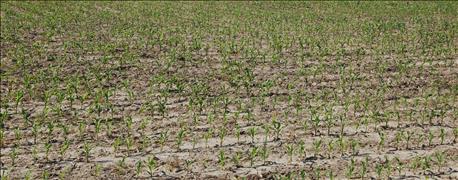
A father and son farm together, but both have their own fields that they own or rent. So both make their own decisions as to what to plant and how to fertilizer. One year ago the son wanted to put liquid N on the surface as his main application of N for corn. Dad wanted his placed below the surface. So both did their own thing. At the end of the season, both harvested similar yields, although there weren’t head-to-head comparisons.

WHICH APPLICATION METHOD WILL WIN THIS YEAR? Early rains last season often took N from surface applications into the soil, meaning little or no additional N loss vs. incorporated methods. However, will this year be similar or will it be dry, setting the stage for losses form surface applications?
The son thinks he had the better idea. It cost him less to apply. He wasn’t making a trip pulling an applicator placing N below the surface. Dad is still going to put his below the surface this year, even though he acknowledged his son’s corn yielded as well last year.
What does dad know that his son doesn’t? He remembers yield trials conducted by then Purdue University Extension soil fertility specialist Dave Mengel some 30 or more years ago. Mengel was primarily comparing surface applications to injected applications of liquid N in no-till corn, as no-till became more widely adapted. The yield levels were lower. But most think the results still apply today. In some cases in some years, Mengel saw a 20 bushel per acre advantage for injecting N vs. applying it on the surface. He never reported significant advantages for applying it on top.
Related: 3 questions you should answer about your soil fertility program
So who is right, father or son? Are minimal short-term savings in application costs worth the risk? Is there really any risk, although Mengel’s work three decades ago, about the time the son was born, would indicate that there is risk.
Bob Nielsen, Purdue University Extension corn specialist, helped lay out the science behind the difference in opinion. Here are the highlights of his explanation.
Understand the forms of nitrogen in 28% liquid N
The first key is to know the forms of N in the product, Nielsen says. Liquid N consists of one-fourth nitrate, one-fourth ammonium and one-fourth urea. It’s all N to the plant, if it is still around when the plant needs it. There are differences in how long these different forms will remain in the soil, largely depending upon weather conditions.
What form of nitrogen plants take up
Plants take up nitrogen in either the ammonium or nitrate form, Nielsen notes. If it is already in the nitrate form, then it is immediately vulnerable to loss. If the N is in the ammonium form, it must convert to nitrate before it becomes vulnerable to loss by denitrification or leaching.
The fate of N forms in liquid nitrogen
The one-fourth that is already in the nitrate form that is immediately available for plants to use is also immediately vulnerable to loss, Nielsen says. The ammonium will need a couple weeks to convert. N in the urea form is not as vulnerable. This description applies to the processes that occur whether the son applies liquid N on top or the father injects liquid N.
Factors that contribute to faster, higher N loss
Here is where the rubber meets the road, and the son and father’s methods vary. When liquid N lays on the surface, it is subject to volatility. What that means, Nielsen says, is that the urea initially convers to ammonia gas, that can be volatilized or lost into the atmosphere. This is especially a problem when fertilizer is in contact with residue, not soil. Losses are double in no-till compared to conventional till. N lost as a gas is obviously not available for crop use.
Role of weather in N losses
If it rains shortly after application, N will be worked into the soil, and will be less subject to loss. It’s the years when you apply N and it lays on the surface for several days in the hot sun when losses are more likely, Nielsen says. A urease inhibitor can be added to liquid N to delay/reduce ammonia lost, but it’s generally not as effective as injection of liquid into the soil.
Short term win for son, long-term odds favor dad!
The son in this example got by with his surface application of liquid N in 2015 because it rained shortly after the application. Rainfall incorporated the N for him. Dad’s N was incorporated when he applied it. So both made it into the soil and were available for use. However, there are years when it won’t work that way, Nielsen says. There is a reason why Mengel saw a 20 bushel disadvantage is some years for surface-applied N vs. injected N. “If each of them stayed with their practice of choice over 10 years, the odds would favor that dad would be right, and get more bang for his buck in the long run,” Nielsen concludes.
About the Author(s)
You May Also Like




